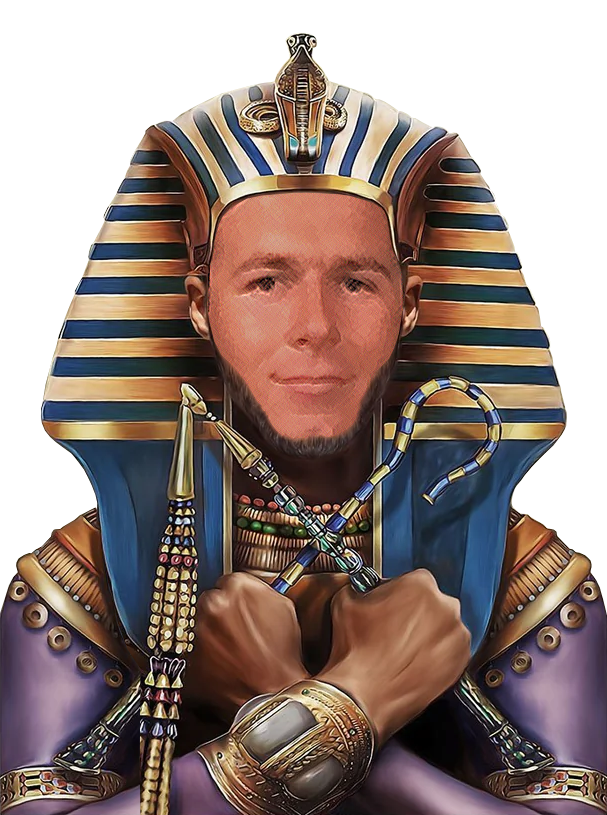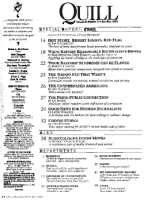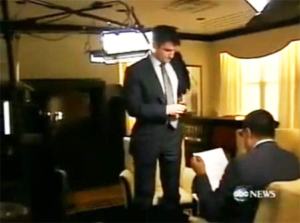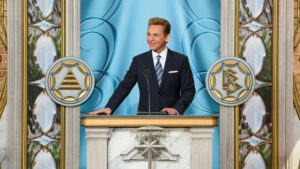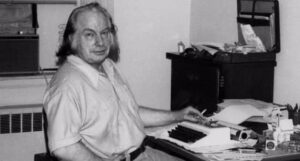
The headline for those who escape follows a similar theme …
“Former Scientology Member Shares Shocking Story.”
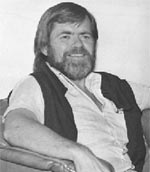 In the late 1980s Robert Vaughn Young “escaped” from Scientology with his then-wife Stacy Brooks. He was one of the highest-level executives to have ever defected from the church. Young made a major contribution to Hubbard’s Church, at least until he learned the truth about L. Ron Hubbard and his past. Robert revealed much of this truth after he escaped from the cult.
In the late 1980s Robert Vaughn Young “escaped” from Scientology with his then-wife Stacy Brooks. He was one of the highest-level executives to have ever defected from the church. Young made a major contribution to Hubbard’s Church, at least until he learned the truth about L. Ron Hubbard and his past. Robert revealed much of this truth after he escaped from the cult.
He was in Scientology for about 21 years. Until Jesse Prince, he was the highest-ranking Scientology executive to speak about the organization without its approval. He was involved in virtually every echelon of the organization, from the franchise where he started in 1969 to working directly with David Miscavige. About 18 of those years were spent in or senior to Dept. 20 (which was called the Office the Special Affairs or OSA), the section that dealt with the ”enemies” of the organization, meaning anyone who disagrees with or criticizes any aspect of Scientology, Hubbard, or ”management.”
Wikipedia: Robert Vaughn Young.
Robert Vaughn Young (April 23, 1938 – June 15, 2003) commonly known by his initials RVY, was an American whistleblower against the Church of Scientology after working high inside their organization for over twenty years.
Young had been a national spokesman for the Church of Scientology. Of his years with the organization, Young said:
I have held nearly every type of position at every echelon. I have worked at the local, the regional, the national and the international levels. I have been a Scientology representative and spokesman before governmental bodies, the media and the courts. I have trained others on how to handle the media and governmental agencies. I have been the most senior public relations executive for Scientology world wide. I worked for years at the echelon that handles critics, “enemies,” the media, judges, the courts and the government. I have been privy to documents and tactics of the most secret nature, including illegalities committed by Scientology executives and the means of cover-up.Young edited L. Ron Hubbard’s ten-volume Mission Earth series. Young said that Hubbard had written the main text of the series, but that he had ghostwritten the introduction of each volume, as well as other writings in Hubbard’s name.
The Mind Benders Title: Hubbard’s “Mission Earth” – the rest of the story
Author: Robert Vaughn Young
Date: 23 Feb 2000 00:08:01 GMT
Saturday, February 19, 2000
L. RON HUBBARD’S MISSION EARTH: the rest of the story
by Robert Vaughn Young**A representative of Scientology’s Dept. 20 has claimed on ARS that I had nothing to do with Hubbard’s last work, “Mission Earth.” I tend to ignore their blathering of these sock puppets but I really took personal umbrage at this one! I was Hubbard’s editor and sometimes-ghost writer and I earned THAT battle ribbon!
In 1989, Young was removed from his job as head of worldwide public relations for the Church of Scientology and sent to the RPF — Rehabilitation Project Force — Scientology’s manual labor re-education camp.
PHOTO: 1975: Vaughn was doing “Snow White” research on Interpol. He was at his desk on the seventh floor of the Manor, where the Guardian’s Office worked.
After leaving the Church of Scientology in 1989, Young became prominent as an expert in court cases regarding Scientology such as CSI v. Fishman and Geertz, BPI v. FACTNet, the Lisa McPherson civil trial, cited by the press, and as an Internet-based critic of the organization.
David Miscavige had sent Mike Rinder and Mike Sutter (link to video comment by Karen de la Carriere) to Seattle to try to silence Vaughn Young and his then-wife Stacey by “making peace” with them. They had almost clinched a deal when Miscavige ordered them to change the terms. That derailed the negotiations and the couple continued to be a thorn in Scientology’s side for many years. Other harassments by the Church came to the attention of Bob Minton, a wealthy financier who was interested in free speech on the internet. He took up the couple’s cause and paid to relocate them to a house outside of Seattle. Through his contact with the Youngs, Minton learned more about Scientology and eventually founded the Lisa McPherson Trust with Stacey Brooks.
Young was diagnosed with prostate cancer on November 23, 1999, and turned his energies to Phoenix5, a non-profit organization that runs a website on the disease. He died on June 15, 2003.
Scientology from the inside out.
Robert Vaughn Young
“This is one of the most important articles ever written on the subject of the cult. Nowhere else are these points explained.” – Jon Atack
Published in Quill, The Magazine of The Society for Professional Journalists; November-December 1993.
Scientology from inside out
A former insider reveals strategies for managing the news media
They say the first step in any recovery program is the admission, so here it is: I handled public relations (PR) and the media for L. Ron Hubbard and his Scientology empire for 20 years.
It is no accident that I avoid saying “Church of Scientology” — the trademarked corporate name. The Scientology world is much larger than merely the “Church” of Scientology.
From 1969 to 1989, I worked at every echelon of the organization, from a small, new “mission” up to national and then international level, including handling media in other countries and working at Hubbard’s personal literary agency. During my tenure, I handled reporters from high school papers and from The New York Times. I have appeared as a Scientology spokesman on radio talk shows and national TV news, as well as in magazines, books, and even a documentary film. I was a member of the Guardian’s Office, the pseudo-naval Sea Organization, and the glitzy Author Services Inc., Hubbard’s literary agency in downtown Hollywood.
When the FBI raided Church of Scientology Guardian offices in Los Angeles and D.C. in 1977, I was the national spokesman, fielding questions on that day and in the months to come.
When Hubbard’s secret international headquarters at Gilman Hot Springs near Hemet, California, was exposed in 1980, I went in to convert the image of the facility overnight. I gave the Los Angeles ABC-TV affiliate a tour of “Golden Era Productions,” the image it still has to this day.
Whispering Winds ranch near Creston, California, where Hubbard spent his final few years in total seclusion before he departed this planet at 8 pm on January 24, 1986.
When Hubbard died in 1986, I was called to his secret California ranch, arriving well before the authorities were called, to help design and implement the strategy to control the media, as well as to calm his followers.
For my training, I studied and had secret directives from Hubbard and others on how to handle reporters, how to deal with police and government agencies, how to create front groups, and how to discredit or destroy a person or a group with Hubbard’s “fair game” doctrine.
I also trained other Scientology PRs on how to handle the media, using material from Hubbard. This included how to respond to a question without answering, how to divert the issue, how to tell “an acceptable truth,” how to stall for time, how to assume various emotional states to control another, how to “attack the attacker,” how to take control of a conversation, how to introvert a person and how to “get the message across” (especially in an age of sound bites), how to help Scientology attorneys write inflammatory legal papers so the PR could then safely use the abusive phrases, and how to appear to be a religion.
This, in brief, is what a journalist faces when encountering a trained and dedicated Scientology PR. The journalist wants a story. The PR wants to kill the story, or at least control it. While this is not particularly unusual, Scientology goes further than most. Scientology stands ready and able to unleash an assault on the journalist that can include private detectives and lawsuits, making it little wonder that publications have grown reluctant to write about the Hubbard empire. (See “Shudder into silence,” Quill, Nov./Dec., 1991.)
Since Scientologists know how the Fourth Estate operates, it’s time the journalist had a chance to learn some of the attitudes, rules, tactics, and tricks known only to Scientology.
1. Your local fanatic.Former church spokesperson, Tommy Davis was interviewed by journalist Martin Bashir for the ABC News program Nightline, in a piece called “Inside Scientology”, which aired in October 2009.[24] Davis ripped off his microphone and stormed off the set of the interview after he was questioned about whether he believed that 75 million years ago a galactic ruler called Xenu brought individuals to Earth and killed them in volcanoes.
Before talking with any Scientology PR or executive, a journalist must know that he or she will be talking to a fanatic — a person seeking to save the world. This is exactly what Scientologists believe they are doing.Moreover, unless you stand ready to print a Scientology story exactly as presented, you will be viewed as an enemy, an agent of the American Medical Association (AMA), a mouthpiece of psychiatry, or someone ready “to sell out the human race if his editor told him to” — in the words of a Hubbard policy letter of August 14, 1963. (This is a key Scientology document. Ask a PR to give you a copy. If he declines, it can be found in the green policy volumes available in any Scientology bookstore.2. You keeping notes?
Know that after your meeting (and after each encounter, including phone calls) the PR will write a debrief. This report will usually be E-mailed to the PR’s superior and up the command channel — and probably also into an intelligence area for filing. Therefore, start your own notes of everything that transpires.3. Image is everything.
Realize that when you are dealing with a PR or official of the Church of Scientology, religious image is not only a vital PR defense (the ecclesiastical equivalent of wrapping oneself in the flag) but is also crucial for tax-exemption purposes and for court cases. Thus the PR must be sure to demonstrate that Scientology is “an applied religious philosophy.” The PR will have many documents to “prove the religious bona fides” of Scientology (but lack anything to the contrary — such as decisions or rulings — of which he may honestly not know).4. The shell game.
When proving the bona fides, PRs make no distinction among the many Scientology corporations. A Los Angeles organization will parade the acceptance of Scientology in London or St. Louis. But when needed, a complex labyrinth of corporations — a veritable hall of mirrors — comes into play. Suddenly no two Scientology organizations touch. Officials of one will act as if they barely know the officials in another. The reason is, of course, the IRS and the courts.So try to find out which corporation you’re talking to and how it relates to the material you are being given. See if the PR or official is willing to go on-record permeating the corporate shells.
Trying to sort out the relations between the Church of Spiritual Technology, World Institute of Scientology Enterprises, and the Religious Technology Center is like trying to solve a Rubik’s Cube. Simply take the shortcut: find the unincorporated Sea Organization (SO). Touted as a “fraternal” organization, the SO is the highest inner circle of Scientology; it was the actual alter ego of Hubbard, the hidden nexus that permeates all corporations. Surprisingly, it has escaped scrutiny.
But asking the SO about the SO is like asking the CIA about the CIA. The difference is the CIA must respond to Freedom of Information Act requests.
5. Say what?
Politicians are notorious for responding to a question without answering it; Scientology PRs practice the skill for hours on end. The PR will drill how to answer simple questions about Scientology, how to “no-answer” a question, how to stall for time, and how to attack. (According to the original material, this included shouting, banging the desk, pointing at the reporter, and swearing.)Thus a seemingly innocuous question such as “What is Scientology?” has already been practiced extensively, and there is a ready answer. More probing questions will produce “no answer.” Therefore a reporter can measure sensitivity by avoidance, and you will find that once you understand this, it is quite easy to spot.
To deal with this, first realize that it is part of the PR’s training. Listen carefully to his or her answers. (Better yet, tape the interview.) When the PR tries to avoid the question with a non sequitur, repeat your question. Continue to repeat your question until you actually get an answer. Ask the PR what drills he or she did before your interview, and ask to see current organization policies on handling the media. (Many are publicly available in Scientology bookstores.)
6. A dead what?
Depending on your story angle, you can easily find yourself buried by packs of documentation. Some are called “DA [dead agent] packs.” Hubbard took the phrase from Sun-tzu’s “The Art of War,” in which different types of agents are described. The “dead agent” is the one who is caught in a lie. The “DA pack” is supposed to counter a lie (thereby rendering the liar “dead” as a credible source) and usually addresses a particular document, from a newspaper article to a book. It is also used to discredit a person or a group that may be a source of criticism of Scientology.A DA pack can include anything from Hubbard’s writings to a piece of press to an affidavit obtained by a private investigator. The purpose is to refute the targeted piece, person or group at virtually any cost. If the article presents no clear-cut falsehoods or errors but paints Scientology in an unfavorable light, the DA becomes a general reply (usually an attack on the source) that may be issued as a pamphlet, an ad, or an article.
Where possible, verify the claims or documentation. Contact the targeted person, group, or author of the article. Also take note of what is not refuted or challenged. In Scientology, omission can be as good as admission.
You can ask to talk to the people who produced the DA pack, but chances are you will not be allowed to, because they are not trained to deal with the media. In Scientology, only trained PRs are supposed to talk to the press. If an exception is made, it will be only those that are proofed up or drilled or have a proven track record of talking to the media about Scientology, and then it is often with a PR present. (A recent example will be found in the September issue of Premiere. The reporter was denied access to Hollywood celebrities in Scientology.) If you can do it, find some staff members who will talk to you. Find some field Scientologists to interview. You’ll learn more from them.7. Go for the gold.
In Scientology, there is an exact chain of command. Each organization has one. The public version is supposed to be posted on a large wall of the organization. It should show the local position of your PR What will not be shown is his or her chain of command.The media are handled by the Office of Special Affairs, or OSA, in the Church of Scientology. The OSA PR will have a senior on the PR chain of command. If the PR is a local OSA staff member (meaning the PR for a city or area), his or her senior will be at the continental level (such as OSA United States, located in Los Angeles) and then at the “int” or international level (OSA Int is also in L.A.). After that, the chain of command jumps to the Religious Technology Center (RTC). In highly unusual circumstances, an RTC official will intervene to handle a journalist, particularly if it is a crucial story for one reason or another, because RTC monitors all OSA activity and is ultimately responsible for any media on Scientology, whether good or bad.
David Miscavige has been the leader of Scientology since 1986 and in the 36 years since he took over from L. Ron Hubbard he has only sat down for one on-camera interview. The interview took place in 1992 with Nightline’s Ted Koppel. There is ZERO chance he will ever be interviewed again.
RTC’s chairman of the board is David Miscavige, who is now the admitted head of the Church of Scientology. His latest intervention will be found in the October issue of Premiere magazine. For any story on Scientology, Miscavige is the one to be interviewed. He lives on the Golden Era Productions property at Gilman Hot Springs. The PR assigned to you will know how to get a message to him. If all else fails, call Golden Era Productions. The personnel there know how to reach him.
Conclusion.
Scientology is in a state of siege with psychiatry, the media, and anything else perceived as attacking Hubbard or the organization. It has been that way since Hubbard named them as enemies decades ago. Talk to a Scientology PR long enough, and you may begin to sense something vaguely familiar about the attitude. walk through a Scientology office, and the proliferation of photographs and busts of Hubbard may strike a familiar chord.Just substitute “Sea Organization” for “Party” in the following passage, and the chilling parallel may be evident:
“Even the humblest Party member is expected to be competent, industrious, and even intelligent within narrow limits, but it is also necessary that he should be a credulous and ignorant fanatic whose prevailing moods are fear, hatred, adulation, and orgiastic triumph. In other words it is necessary that he should have the mentality appropriate to a state of war. It does not matter whether the war is actually happening, and, since no decisive victory is possible, it does not matter whether the war is going well or badly. All that is needed is that a state of war should exist. The splitting of the intelligence which the Party requires of its members, and which is more easily achieved in an atmosphere of war, is now almost universal, but the higher up the ranks one goes, the more marked it becomes. It is precisely in the Inner Party that war hysteria and hatred of the enemy are strongest. In his capacity as an administrator, it is often necessary for a member of the Inner Party to know that this or that item of war news is untruthful, and he may often be aware that the entire war is spurious and is either not happening or is being waged for purpose quite other than the declared ones; but such knowledge is easily neutralized by the technique of double-think meanwhile no Inner Party member wavers for an instant in his mystical belief that the war is real, and that it is bound to end victoriously, with Oceania the undisputed master of the entire world.” –George Orwell, “1984”Additional insights on Young’s comparison to Orwell’s “1984.”
How To Fool The Press: A study in misinformation
by Robert Vaughn YoungIn nearly 20 years of handling the media for Scientology and Hubbard, I dealt with a lot of journalists. One of the most challenging occurred in 1980, when the Riverside Press-Enterprise broke a story by Dick Lyneis that Hubbard was secretly ensconced at a nearby deserted resort called Gilman Hot Springs.
L. Ron Hubbard was named by federal prosecutors as an “unindicted co-conspirator” in Operation Snow White and went into hiding for the rest of his life.
Since the FBI raid on Scientology offices in 1977, Hubbard had been the target of an increasing number of process servers and government investigators. His location had become one of Scientology’s best-kept secrets. When necessary, Hubbard could move and he did.
But the headquarters of Scientology International in Gilman Hot Springs could not move so easily. Although Hubbard claimed not to be running the Church of Scientology, in fact he did. Here was the seat of the Hubbard Holy Empire, 90 minutes east of Los Angeles. Hubbard was not eager for attorneys, the media, or the Internal Revenue Service to know this.
I was sent in to handle the situation.
As in Clearwater, Florida, Scientology had covertly bought the Gilman Hot Springs property and secretly moved in. The phone book listed it as the “Scottish Highland Quietude Club.” Few driving by were interested in the few people who occasionally walked between the buildings.
By the time I arrived, Hubbard had disappeared. Most of the staff he had deserted were terrified because t he security he had demanded had been blown. They knew his temper and they feared his wrath.
I toured the property and found a small film-making area and an audio tape production unit, called Golden Era, which was supposed to supply materials to the Church of Scientology. Both had been shut down by Hubbard, but I saw my solution. It was, as he called it, “an acceptable truth.” I obtained L.A.’s approval for my plan.
Through that night and into the morning, the facility was converted. I had the paper covering all the windows taken off. Everything was cleaned. Equipment and desks were rearranged to hide certain tasks and to create others. Tapes, films, scripts, and costumes were dragged out and made obvious. Many international management staff were sent off the base to reduce the number of personnel.
The next day, the “Scottish Highland Quietude Club” had become Golden Era Studios. A media tour went without a hitch. The tape-production area wasn’t cranking yet, but I did get people busy making costumes and booklets or doing artwork. We found a makeshift studio that “just happened” to be working when the tour came through. Asked about “international management,” I said yes, they did manage distribution of films and tapes, which did go to churches worldwide. No one noticed I had avoided the question and diverted attention to the film and tape production.
The news that night was perfect. The Riverside Press-Enterprise store had been countered. Gilman was no longer considered the headquarters of Scientology. It was just a bustling film and tape facility that supplied the Church of Scientology.
When the flap died down, international management quietly moved back in. Since then Golden ERA Productions has expanded considerably. There are even guided public tours and PR glitz, including an occasional VIP or Scientology celebrity tour of the tape and film facilities. No one asks about the other function we were able to quietly reinstall after the flap was handled., or the other management organizations that were quietly added.
But they’re there, just up the hill from the sound stage, not too far from the spa where the hot springs no longer flow.
Toward A New Model Of “Cult Control”
By Robert Vaughn Young
After I left Scientology in 1989 with 21 years in the cult, the hardest question people posed to me was why I stayed in it so long if I knew it was such an abusive system. I didn’t have an answer that satisfied me, let alone anyone else. I think I’ve come up with a reply and a model. It at least satisfies me today.
My own background and basic interests also demanded an answer to that question. I had a pursued and obtained a BA in philosophy (from what was then known as San Francisco State College) because of a strong interest in what we called philosophy of behavior/mind/psychology.
The first time I saw the parallel between my own experiences in the cult of Scientology and battered women was when I was reading “Captive Hearts, Captive Minds,” which is an excellent book. It was in the Intro or maybe the first chapter that they cited and quoted the singer Tina Turner who had been in an abusive relationship for something like 10 or 15 years. She remarked how being with Ike Turner was like being in a small cult. The remark jumped off the page at me. Given the success of Tina Turner as an entertainer, one is not prone to say she is a stupid woman but there she was in a marriage where she was beaten constantly and yet she stayed. When she finally escaped, as she tells her story, it was after a beating that left her head so swollen that she couldn’t put on a wig. She wrapped her head in a scarf and fled, taking no money or anything and finally got away from Ike Turner.
…
Why doesn’t she just leave? It’s the question many people ask when they learn that a woman is suffering battery and abuse. But if you are in an abusive relationship, you know that it’s not that simple. Ending a significant relationship is never easy. It’s even harder when you’ve been isolated from your family and friends, psychologically beaten down, financially controlled, and physically threatened.
No abusive relationship starts that way. In fact, the chances are that if the guy had slapped her on the first date, there wouldn’t be a second one. No, the abusive relationship starts with sweetness. When I was reading about abusive relationships, that came up constantly, how the guy was so nice and sweet. No, the abuse is gradual. It starts with some criticism and when the woman accepts it, then there is a little bit more. When she accepts that, the man does more as he introduces CONTROL. If she protests, he backs off until he can reestablish the control. It is called a GRADIENT. (Ironically, Scientologists will be familiar with that word.) The woman comes to accept more and more and becomes convinced that it is something SHE is doing wrong. As it is increased, the sweetness tapers off until it is finally dangled in front of her like a carrot. Somewhere along the line, the physical abuse starts. If she breaks too hard, he is sweet and comforting and maybe even apologetic, bringing her back under control. That is the key. CONTROL. (Another word Scientologists know well. Hubbard even had his own definition for it and processing addressing control.) Then one day the beatings are regular and she loses her self-respect and dignity.
…
Thanks to video cameras, we can watch shows like “Cops” where the police are called out to a real life “domestic disturbance.” If you have watched that show enough, you finally saw the all-to-familiar scene of the woman with a bloody nose who has clearly been beaten (the cops were called by neighbors hearing the fight) and is standing there explaining it all away, insisting that the police take no action. No, she’s fine, she says. No, it’s nothing. To the questions from the police about the bloody nose or the swelling around the eyes, she’ll say anything but the facts, that he was beating her. Do we need more evidence? There are the very people – the police – who can take him off to jail and end the abuse if she will simply speak up and she refuses while wiping the blood from her nose or pulling the torn clothing up around her shoulder and telling them that everything is okay. Of course, the police cannot legally intervene unless she complains and she will not.
Now let me make a harrowing admission. If the police had shown up that day when I was at the motel trying to escape, when the security guards were parked outside to make sure I didn’t disappear on them, and if the police had asked me if everything was okay or if I needed any help, do you know what I would have said and done? The same thing as that woman. No, it’s fine, I would have said. I’ll handle it. It stuns me to think it, let alone say it right now, but that is the truth. That is exactly what I would have done. And do you know why? Because I didn’t want to be in trouble with the cult. If you can figure that one out, give it to the experts.
There are only two answers for the handling of people from 2.0 down on the Tone Scale, neither one of which has anything to do with reasoning with them or listening to their justification of their acts. The first is to raise them on the Tone Scale by un-enturbulating some of their theta by any one of the three valid processes. The other is to dispose of them quietly and without sorrow.
— L. Ron Hubbard
The purpose of [a lawsuit] is to harass and discourage rather than to win. The law can be used very easily to harass, and enough harassment on somebody who is simply on the thin edge anyway, well knowing that he is not authorized, will generally be sufficient to cause his professional decease. If possible, of course, ruin him utterly.
— L. Ron Hubbard
This [Scientology] is useful knowledge. With it the blind again see, the lame walk, the ill recover, the insane become sane and the sane become saner. By its use the thousand abilities Man has sought to recover become his once more.
— L. Ron Hubbard
People attack Scientology, I never forget it, always even the score. People attack auditors, or staff, or organisations, or me. I never forget until the slate is clear.
— L. Ron Hubbard
